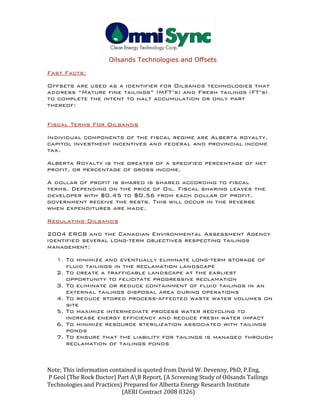
OmniSync Fast Facts
- 1. Oilsands Technologies and Offsets Note; This information contained is quoted from David W. Devenny, PhD, P.Eng, P Geol (The Rock Doctor) Part AB Report, (A Screening Study of Oilsands Tailings Technologies and Practices) Prepared for Alberta Energy Research Institute (AERI Contract 2008 0326) Fast Facts: Offsets are used as a identifier for Oilsands technologies that address “Mature fine tailings” (MFT’s) and Fresh tailings (FT’s) to complete the intent to halt accumulation or only part thereof: Fiscal Terms For Oilsands Individual components of the fiscal regime are Alberta royalty, capitol investment incentives and federal and provincial income tax. Alberta Royalty is the greater of a specified percentage of net profit, or percentage of gross income. A dollar of profit is shared is shared according to fiscal terms. Depending on the price of Oil. Fiscal sharing leaves the developer with $0.45 to $0.56 from each dollar of profit, government receive the rests. This will occur in the reverse when expenditures are made. Regulating Oilsands 2004 ERCB and the Canadian Environmental Assessment Agency identified several long-term objectives respecting tailings management: 1. To minimize and eventually eliminate long-term storage of fluid tailings in the reclamation landscape 2. To create a trafficable landscape at the earliest opportunity to felicitate progressive reclamation 3. To eliminate or reduce containment of fluid tailings in an external tailings disposal area during operations 4. To reduce stored process-affected waste water volumes on site 5. To maximize intermediate process water recycling to increase energy efficiency and reduce fresh water impact 6. To minimize resource sterilization associated with tailings ponds 7. To ensure that the liability for tailings is managed through reclamation of tailings ponds
- 2. Oilsands Technologies and Offsets Note; This information contained is quoted from David W. Devenny, PhD, P.Eng, P Geol (The Rock Doctor) Part AB Report, (A Screening Study of Oilsands Tailings Technologies and Practices) Prepared for Alberta Energy Research Institute (AERI Contract 2008 0326) 2009 of February the ERCB issued “Directive 074” it requires Oilsands operators to solidify increasing amounts of fluid tailings each year, report on fines management and report on the performance of each tailings facilities annually. Extraction of Oilsands Ore Suncor and Syncrude add caustic soda in extraction to felicitate bitumen removal. Caustic soda also disperses clay, that adds to the volume of fluid tailings created. Albian Sands proposed to operate extraction without adding dispersing agents. For the reason of anticipated superior performance in tailings that are denser, rapidly settling tailings and faster water clarification. However the requirement for the project was to add sodium citrate a dispersing agent to aid bitumen extraction that inherently adds additional tailings. Traditional extraction produces waste that can be pumped. The upper limit for the strength of pumpable waste is 100kPa, however that’s 1% of the strength desired for reclamation. Taiings Pond Behaviour The tailings ponds can be prepared to large vessel that clarifies water and provides storage for fine-grained deposits. Material that enters the tailings pond consists of water, unrecovered bitumen, and silt, Clay dissolved chemicals dissolved chemicals, solvent losses, and process aids. The waste slurry entering the tailings ponds is quite dilute, with a typical solid content of 5% to 10%. Suspended solids slowly settle leaving clear water behind. As the solids the suspension becomes denser and particles interfere with each other. This Transition zone extends to the depth of few meters, finally the density reaching 30% solids, repulsive forces between clay particles prevent further densification. The deposit at that stage is known as Mature Fine Tailings or MFT’s.
- 3. Oilsands Technologies and Offsets Note; This information contained is quoted from David W. Devenny, PhD, P.Eng, P Geol (The Rock Doctor) Part AB Report, (A Screening Study of Oilsands Tailings Technologies and Practices) Prepared for Alberta Energy Research Institute (AERI Contract 2008 0326) Volume of Tailings Ponds Forecasting tailings volumes so storage facilities can be constructed and ready to store expected tailings. Fast facts: Waste volumes for Base case and all thicker cases MFT’s is considered to be end product, volume of waste created on average 1.3 cubic metres per cubic metre of Ore for all cases, seventy-five % is sand 25% of that is tailings ponds. Base Case: 1.320 m3 Thickner1 WO cyclones: 1.301 m3 Thickner1 W cyclones: 1.286 m3 CT-2 processing internal TT: 1.108 m3 Centrifuge case: 1.318 m3 OmniSync CET processing: 0 m3 *Centrifuge case waste volume is relatively high, due to fine waste is not stored in the void space of the sand. Migrating offsets can add to opex cost by $10.00 to $15.00 cubic metres per cubic metre of Ore OmniSync CET processing: No Migrating offsets Immediate solidification Immediate Water recovery